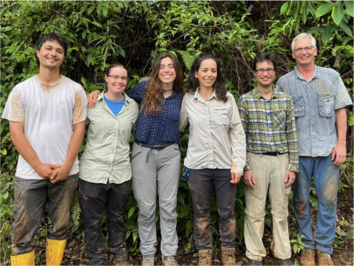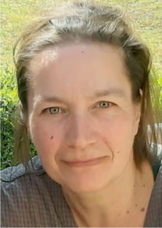• Deciphering the Effect of Vegetation and Erosion on basalt and carbonate weathering by Novel Denudation Rate Approaches
ERC Advanced Grant „DEVENDRA“ Deciphering the Effect of Vegetation and Erosion on basalt and carbonate weathering by Novel Denudation Rate Approaches

Grant Awardee: Prof. Friedhelm von Blanckenburg
f.v.b.@fu-berlin.de
The DEVENDRA project aims to develop innovative methods to quantify the dissolution of basalt and carbonate rocks and to decipher their impact on Earth’s vegetation and climate system.

Project description:
The chemical weathering of rocks on the Earth’s surface draws down atmospheric CO2, balancing emissions from volcanoes and maintaining habitable temperatures. Basalt and carbonate rocks are particularly crucial in this balance, because they are efficiently weathered. To formulate sensitivities and feedbacks between weathering of these rocks and climate, we need an accurate description of the exact processes that drive the conversion of rock to soil by weathering. Besides water flow, erosion rate and vegetation are thought to exercise significant control. The chemical composition of water flowing in rivers are commonly used to infer the weathering rates. Currently, however, we lack the tools needed to decipher the underlying controls when rock turns to soil, because the preferred approach used to quantify erosion and weathering rates – cosmogenic nuclides, produced in situ in quartz – does not work in basalt and carbonate lithologies.
The aim of DEVENDRA, dedicated to the pioneer of cosmogenic nuclide geochemistry Devendra Lal (1920 – 2012), is to eliminate this blind spot using a novel method never applied to basalt and carbonate lithologies: the ratio of cosmogenic beryllium-10 rained out from the atmosphere to stable beryllium-9 released by weathering. DEVENDRA will develop this system as a novel erosion and weathering rate meter for these rocks, and will use this new method to calibrate – using globally-distributed soil profiles and catchments of differing climate and erosion rate – the laws that govern weathering and CO2 drawdown in these rocks. The outcomes from DEVENDRA will refine the global weathering models that are used to understand Earth’s carbon cycle on geological time scales, to predict the trajectory of anthropogenic CO2 in coming centuries, and to estimate the potential for negative CO2 emissions by artificially-enhanced weathering of basalts.
DEVENDRA is hosted by the Geochemistry Group, Department of Earth Sciences, Freie Universität Berlin with the Section Earth Surface Geochemistry, German Research Centre for Geosciences GFZ Potsdam as Co-PI.

Dedicated to Devendra Lal (1920 – 2012) grand pioneer of cosmogenic nuclide geochemistry (Foto from https://doi.org/10.1098/rsbm.2020.004 )
The Objectives of DEVENDRA:
- Method Development: Establish the (10Be(meteoric)/9Be) ratio as an innovative erosion and weathering rate meter for basalt and carbonate rock – thereby exploring new avenues in cosmogenic nuclide geochemistry
- Deciphering Climate Control: Disclose the vegetation and erosion controls over basalt and carbonate weathering along a global climosequence consisting of a humid, a mediterranean, a tropical, and an arctic field site.
- Applications to the global carbon cycle and enhanced weathering: Derive relationships describing the production of solutes in rivers as input to global weathering models that investigate the regulation of Earth’s climate over geologic time scales and explore whether 10Be(meteoric)/9Be serves as a quantification tool for enhanced basalt weathering.

Project Work Packages:
- Getting the 10Be/9Be system fit for basalt and carbonate10Be(meteoric)/9Be is developed as a new and reliable proxy for denudation rates at soil- and catchment-scales in lithologies that were hitherto inaccessible: basalt and carbonate rock.
- Basalt and carbonate rock weathering and erosion rates along a climosequenceThe new method will be employed at field sites that comprises a “climosequence” (sites that differ in erosion rate) as well as an “erodosequence” (sites that differ in erosion rate), because varying uplift, topography and climate-controlled runoff as well as vegetation control weathering.
- Marrying the river dissolved world with the world of solid denudation fluxesRelationships derived from the DEVENDRA study sites will be formulated for input into global weathering models used to investigate the regulation of Earth’s climate over geologic time scales, and the efficiency of enhanced weathering as a CO2 reduction strategy.
Project Team:

The DEVENDRA-Team at the end of doing field work in Columbia (left to right: Nicholas Iff, Clara Geneste, Chiara Bazzucchi, Hella Wittmann, David Uhlig, Friedhelm von Blanckenburg)

Friedhelm von Blanckenburg, Freie Universität Berlin, PI, Earth Surface Geochemistry

Hella Wittmann-Oelze, GFZ Potsdam, Co-PI, Meteoric cosmogenic Be Isotopes

David Uhlig, FU Berlin (Postdoc): Critical Zone Geochemistry

Chiara Bazzucchi, FU Berlin (Postdoc): Carbonate Weathering

Nicholas Iff, FU Berlin (Doctoral Student): Basalt Weathering

Clara Geneste, FU Berlin (Doctoral Student): Basalt Weathering
Sebastian Focke, GFZ Potsdam (Technician)
Project Office:
Britta Ernst, Freie Universität Berlin
Previous literature on this topic from members of the project team:
- Uhlig, D., Sohrt, J., von Blanckenburg F. 2024. Imbalances in dissolved elemental export fluxes disclose “hidden” Critical Zone compartments. Water Resources Research. 60.
- Wittmann, H., Bouchez, J., Calmels, D., Gaillardet, J., Frick, D. A., Stroncik, N., ASTER Team, von Blanckenburg, F. 2024. Denudation and weathering rates of carbonate landscapes from meteoric 10Be/9Be ratios. Journal of Geophysical Research: Earth Surface, 129(9)
- Dannhaus, N., H. Wittmann, P. Krám, M. Christl, and F. von Blanckenburg, Catchment-wide weathering and erosion rates of mafic, ultramafic, and granitic rock from cosmogenic meteoric 10Be/9Be ratios. Geochimica et Cosmochimica Acta, 2018, 222, p. 618-641.
- Deng, K., Wittmann, H., von Blanckenburg, F., 2020. The depositional flux of meteoric cosmogenic 10Be from modeling and observation. Earth and Planetary Science Letters 550.
- Deng, K., Wittmann, H., Yang, S., Blanckenburg, F., 2021. The Upper Limit of Denudation Rate Measurement From Cosmogenic 10Be(Meteoric)/9Be Ratios in Taiwan. Journal of Geophysical Research: Earth Surface 126.
- Maher, K. and F. von Blanckenburg, Surface ages and weathering rates from Be-10 (meteoric) and Be-10/Be-9: Insights from differential mass balance and reactive transport modeling. Chemical Geology, 2016, 446, p. 70-86.
- Maher, K., von Blanckenburg, F., 2023. The circular nutrient economy of terrestrial ecosystems and the consequences for rock weathering. Frontiers in Environmental Science 10.
- Uhlig, D., von Blanckenburg, F., 2019. How Slow Rock Weathering Balances Nutrient Loss During Fast Forest Floor Turnover in Montane, Temperate Forest Ecosystems. Frontiers in Earth Science 7.
- von Blanckenburg, F., J. Bouchez, and H. Wittmann, Earth surface erosion and weathering from the Be-10 (meteoric)/Be-9 ratio. Earth and Planetary Science Letters, 2012, 351, p. 295-305.
- von Blanckenburg, F., J.A. Schuessler, J. Bouchez, P.J. Frings, D. Uhlig, M. Oelze, Frick, D.. . . K. Norton, Rock weathering and nutrient cycling along an erodosequence. American Journal of Science, 2021, 321.
- Willenbring, J.K., von Blanckenburg, F., 2010. Meteoric cosmogenic Beryllium-10 adsorbed to river sediment and soil: Applications for Earth-surface dynamics. Earth-Science Reviews 98, 105-122.
- Wittmann, H., von Blanckenburg, F., Dannhaus, N., Bouchez, J., Gaillardet, J., Guyot, J.L., Maurice, L., Roig, H., Filizola, N., Christl, M., 2015. A test of the cosmogenic 10Be(meteoric)/9Be proxy for simultaneously determining basin-wide erosion rates, denudation rates, and the degree of weathering in the Amazon basin. Journal of Geophysical Research: Earth Surface 120, 2498-2528.
